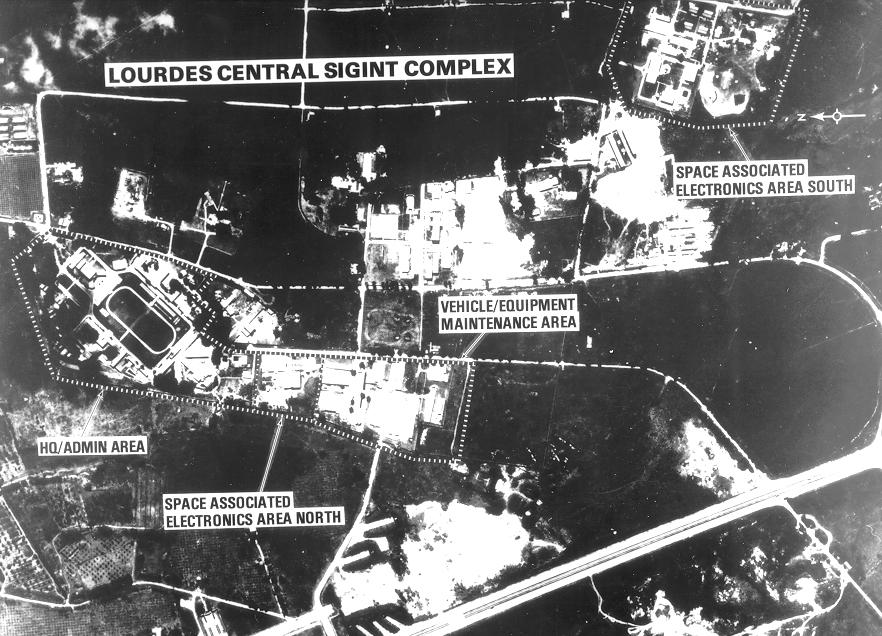FAS | Intelligence | IMINT Gallery | Cuba | Index | Search | Join FAS



Lourdes [Cuba]
Signals Intelligence (SIGINT) facility
23°00'01"N 82°28'56"W
Update: On October 17, 2001, Russian President Putin announced that the Lourdes facility would be shut down. President Bush welcomed the decision.Cuba has an agreement with Russia which allows Moscow to maintain a signals intelligence facility near Havana at Torrens [23°00'01"N 82°28'56"W], also known as Lourdes, which is the largest Russian SIGINT site abroad. The strategic location of Lourdes makes it ideal for gathering intelligence on the United States. It has been reported that the Lourdes facility is the largest such complex operated by the Russian Federation and its intelligence service outside the region of the former Soviet Union. The Lourdes facility is reported to cover a 28 square-mile area with 1,000-1,500 Russian engineers, technicians, and military personnel working at the base. Experts familiar with the Lourdes facility have reportedly confirmed that the base has multiple groups of tracking dishes and its own satellite system, with some groups used to intercept telephone calls, faxes, and computer communications, in general, and with other groups used to cover targeted telephones and devices.
According to American intelligence, an unusually large number of Soviet ships delivered military cargoes to Cuba beginning in late July 1962, to support the construction of a variety of military activities, including setting up facilities for electronic and communications intelligence. In the area just south of Havana city, a number of farms were evacuated and the boys' reformatory at Torrens, two and one half miles on the road to San Pedro from Havana, was converted for living quarters for numbers of foreign personnel. The numerous Soviet personnel who moved in early in August 1962 wore casual, dirty, civilian clothes.
The SIGINT facility at Lourdes is among the most significant intelligence collection capabilities targeting the United States. This facility, less than 100 miles from Key West, is one of the largest and most sophisticated SIGINT collection facilities in the world. It is jointly operated by Russian military intelligence (GRU), FAPSI, and Cuba's intelligence services. The Federal Agency for Governent Conununications (FAPSI) evolved in the early 1990's from the former KGB's SIGINT service. According to Russian press sources, the Russian Foreign Intelligence Service (SVR) also has a communications center at the facility for its agent network in North and South America.
The complex is capable of monitoring a wide array of commercial and government communications throughout the southeastern United States, and between the United States and Europe. Lourdes intercepts transmissions from microwave towers in the United States, communication satellite downlinks, and a wide range of shortwave and high-frequency radio transmissions. It also serves as a mission ground station and analytical facility supporting Russian SIGINT satellites.
The facility at Lourdes, together with a sister facility in Russia, allows the Russians to monitor all U. S. military and civilian geosynchronous communications satellites. It has been alleged that the Lourdes facility monitors all White House communications activities, launch control communications and telemetry from NASA and Air Force facilities at Cape Canaveral, financial and commodity wire services, and military communications links. According to one source, Lourdes has a special collection and analysis facility that is responsible for targeting financial and political information. This activity is manned by specially selected personnel and appears to be highly successful in providing Russian leaders with political and economic intelligence.
From this key facility, first the Soviet Union and now Russia have historically monitored U.S. commercial satellites, and sensitive communications dealing with US military, merchant shipping, and Florida-based NASA space programs. According to a 1993 statement by Cuban Defense Minister Raul Castro, Russia is said to obtain 75 percent of its military strategic information from Lourdes.
The Lourdes facility enables Russia to eavesdrop on US telephone communications. US voice and data telephone transmissions relayed by satellites visible to the facility are vulnerable to Russian intercept. Although sensitive U.S. goverrunent conununications are encrypted to prevent this intercept, most other unprotected telephone communications in the United States are systematically intercepted. In addition to its military strategic value, Lourdes will increasingly be used to support the Russian economy, a current FAPSI priority. In addition to unprotected commercial information, personal information about U.S. citizens in the private and goverrunent sectors also can be snatched from the airwaves and used by Russian intelligence to identity promising espionage recruits in these sectors. In October 1995, Cuba and Russia produced an agreement on the continued functioning of the site until the year 2000. Although the amount of Russian compensation for the site is unclear, a 1994 agreement called for Russia to provide Cuba approximately $200 million worth of fuel, timber and spare parts for various equipment, including military, for the operation of the facility during that year. The strategic significance of the Lourdes facility has possibly grown since the 07 February 1996 directive from Russian President Boris Yeltsin directing the Russian intelligence community step up the acquisition of American and other Western economic and trade secrets. However in congressional testimony delivered on March 16, 1995, Assistant Secretary of State for Inter-American Affairs Alexander Watson stated that pressuring Russia to discontinue SIGINT activities in Cuba "could limit our ability to promote reform and stability in Russia" as it could "be seen by the Russians as interfering with the exercise of their right under the START Treaty to monitor compliance with the agreement...."In contrast to the situation in the early 1980s, when the bulk of US voice traffic was carried by microwave, Lourdes can no longer intercept a significant fraction of US telecommunications, because most US telecommunications do not any longer travel via microwave radio. At the very best the Lourdes facility might possibly be able to see occasional microwave scatter traffic from southern Florida and the Caribbean on very good days. But the facility is well placed to intercept domestic and international satellite traffic from US satellites with footprints that include the Caribbean.
Section 106(d) of the Helms/Burton Legislation [P.L. 104-114] signed into law on 12 March 1996, withholds U.S. assistance from Russia by an amount equal to the sum of assistance and credits provided (on or after the enactment of this provision) in support of the Russian intelligence facility at Lourdes, Cuba. However, the provision includes a presidential waiver if such assistance to Russia is in the US national security interest, and if the President certifies that Russia is not sharing intelligence data collected at Lourdes with officials or agents of the Cuban government.

Sources and Methods
- Defense Intelligence Agency answers to questions for the record [excerpts] CURRENT AND PROJECTED NATIONAL SECURITY THREATS TO THE UNITED STATES AND ITS INTERESTS ABROAD February 22, 1996 - Senate Select Committee on Intelligence
- PROPOSED CUBAN LEGISLATION - Alexander F. Watson, Assistant Secretary of State for Inter-American Affairs [House Western Hemisphere Subcommittee, 16 March 1995 ]
- Federal Agency for Government Communications & Information (FAPSI)
FAS | Intelligence | IMINT Gallery | Cuba | Index | Search | Join FAS
http://www.fas.org/irp/imint/c80_04.htm
Created by John Pike
Maintained by Steven Aftergood
Updated Saturday, October 18, 2001